Frustrated with liquid soap making? Let’s troubleshoot! Here are some of the most common problems and their solutions.

Over the years, I’ve gotten a lot of questions from people making liquid soap. They often write me in a panic, right in the middle of their first batch. Unfortunately, despite my trying to help answer as quickly as I can, I can’t always be around to answer questions immediately.
I decided that it would be a good idea to consolidate the main problems here and link to this troubleshooting guide from my various liquid soap recipe posts. As we find more questions and more solutions, I’ll try to periodically update this post with more information.
So, let’s get to the main problems people have when making liquid soap…
Hard soap paste
Soap paste should be malleable. It’s a putty-like substance that you can stretch and pull into different shapes. If, rather than having a soap paste, you have what appears to be a bar soap, it may be that you actually did make a bar soap instead.
Several people have come to me with this problem, and we later discovered that they had used NaOH (sodium hydroxide) rather than KOH (potassium hydroxide) when making their liquid soap.
While both NaOH and KOH are often referred to as lye, they are not directly interchangeable.
NaOH is the type of lye generally used to make solid soaps like bar soap. KOH is the type of lye generally used to make liquid soap. Some soaps like cream soaps and shave soaps will use a combination of the two types of lye to get a different consistency.
How to fix it
If you did make a soap with NaOH vs. KOH, you can still dilute it and try to dilute it, but you are really diluting a solid soap in water rather making a true liquid soap. You could also use it as a bar soap.
Keep in mind that your resulting soap will likely not be ideal as the same amount of oil generally calls for more KOH than NaOH. That means that if you accidentally used NaOH in a recipe meant for KOH, your resulting soap will likely be lye heavy. (I’d suggest using it for general purpose cleaning as it may be irritating to the skin. If made with coconut oil, it will likely be a good laundry soap.)
While you could try to rebatch the soap, melting it down and mixing it with more oil, that may or may not work well. To know how much oil to add, use a lye calculator. (For more information, read my post on how to use a lye calculator.)
Other possible problems
If the soap is mostly malleable, but still quite hard, it could be that too much of the water evaporated when cooking the soap paste. To prevent this from happening, cover the soap while cooking it. In the end, though, this isn’t really a cause for concern as you’ll be adding water again when you dilute the soap.
Cloudy liquid soap
There are several reasons that a liquid soap may turn cloudy (or be cloudy straight from the beginning). Generally, it’s only a cosmetic issue and you should be able to safely use cloudy liquid soap.
Superfatted liquid soap
Superfatting is the concept of having more oils in your recipe than the amount needed to react with the amount of lye in your soap recipe.
It’s not that liquid soap can’t be superfatted, but it can’t be superfatted by as much as a bar soap can and still remain clear. Some people are successful in superfatting their liquid soaps up to 3%. (In comparison, a bar soap is generally superfatted to 5% and is often superfatted more than that.)
To know if this is the issue, allow the soap to rest for a day or two. If a cloudy, oily layer floats on the surface, that’s either a sign of excess oils or unsaponifiables. (Certain oils have components that won’t react with the lye to form soap.)
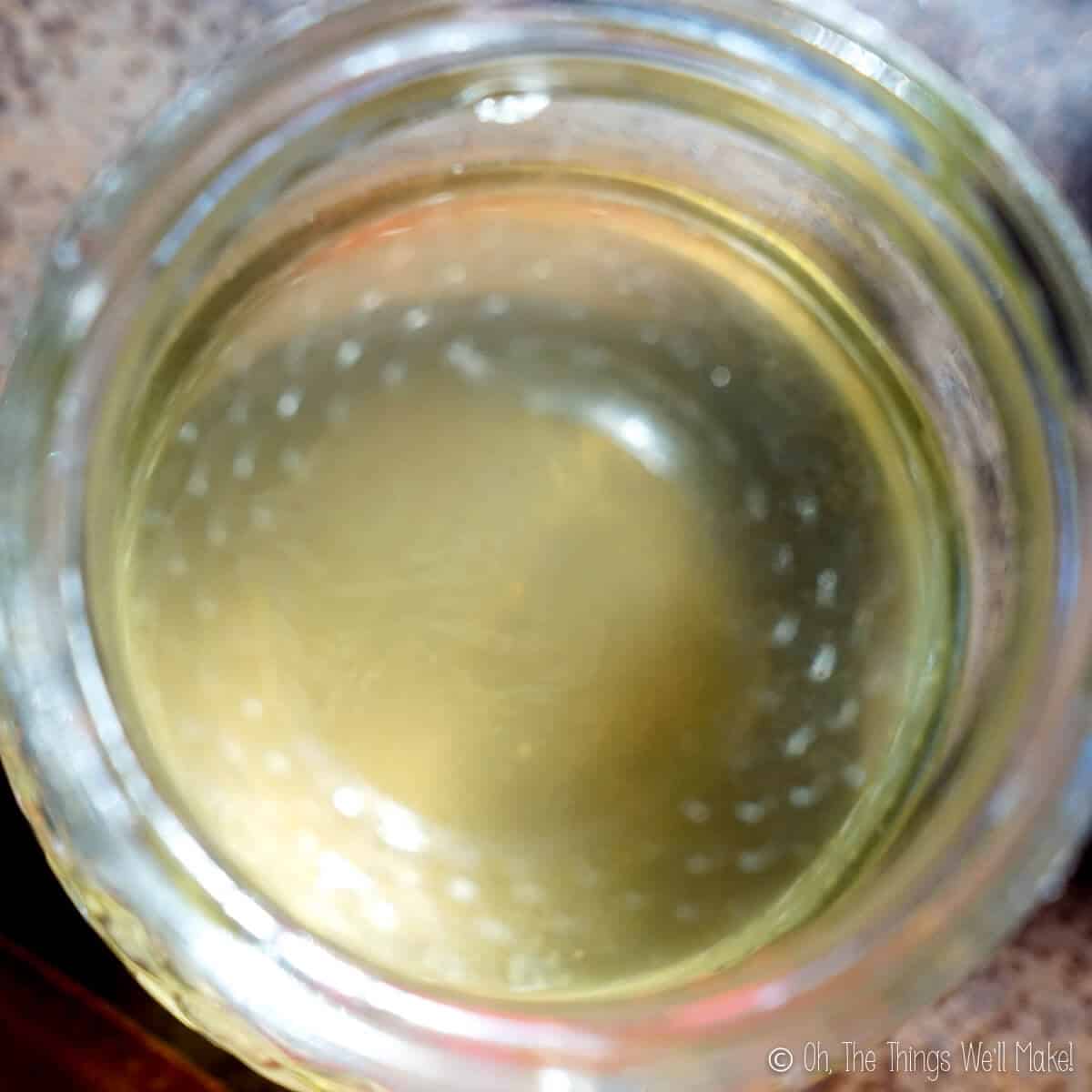
How to fix it
If you have too many leftover oils in your liquid soap, those excess unsaponified oils will make your liquid soap cloudy. This is mainly a cosmetic problem and can be fixed by adding in a tiny amount of KOH solution if you’re really set on having a clear soap. (Calculate the amount needed using a lye calculator.)
Temperature
Liquid soap can be temperature sensitive!
When I made my first batches of liquid soap one autumn, I diluted part of the paste slightly to make it easier to combine my various soaps together more quickly.
Background story: I had made a pure Castile liquid soap with only olive oil and a liquid soap made with only coconut oil. My thought was to combine them, as needed, to benefit from the qualities of each soap. I stored them in a slightly diluted state to make the mixing process easier. I then further diluted them as I combined them for different uses around the house.
Several weeks later, I was surprised to find that those slightly diluted soap pastes had started to turn opaque and much thicker!
It turns out that as the weather got colder, my soaps turned more opaque and thicker just like coconut oil solidifies when in a cold environment!
I wasn’t too surprised when the coconut oil soap did that, but my beginner liquid Castile soap made with only olive oil did the exact same thing a few days later!
I had my suspicions that the cold environment was the issue, but wasn’t able to confirm it until later on that spring when some of my thicker liquid soaps, left as-is as an experiment, turned perfectly clear and beautiful again. Leaving them untouched, I found that later that winter, they become very thick, opaque and a bit gloopy again.
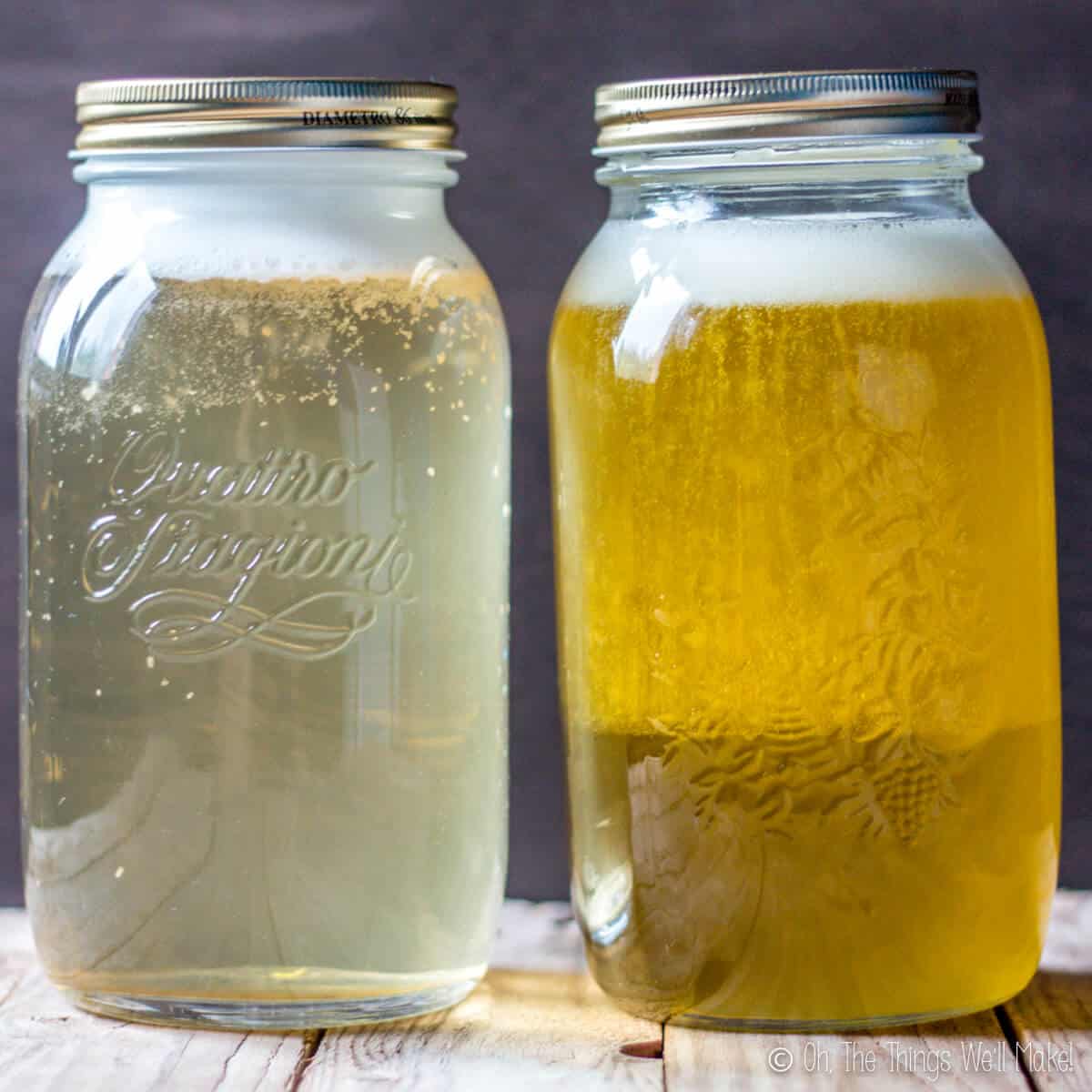
How to fix it
This, again, is a cosmetic issue, and it mainly affects soap that you haven’t diluted much. (Different people dilute their soaps at different rates.)
You can still use your soap in a cold environment and have it clear. You’ll just need to dilute it a little more to get it thinner and clearer again.
Liquid soaps are generally much thinner than commercial “soap” gels that you find for sale. I compared Dr. Bronner’s soap with mine and found that it also had quite a thin consistency.
If it bothers you that your soap is too thin, you can either try to thicken it with some sort of thickener, or you can dispense it in a foaming soap pump to give a mousse-like consistency when you want to use it.
Oil used
Let’s face it. Not all oils make great looking liquid soaps.
At first, I experimented with different oils when making liquid soaps. I added soaps like hemp oil and jojoba oil when making a Dr. Bronner’s copycat recipe (because they use them). I found, though, that when using too many of those oils, I ended up with a cloudy layer that floated on top of my soap.
After a bit of investigation, I learned that jojoba oil generally makes a cloudy soap because it has too many unsaponifiables (aka. parts of the oil that don’t saponify or turn into soap).
Since then, I generally stick to using only coconut oil and/or olive oil. I’ve read that castor oil is another good alternative to add to your other oils in liquid soap making, but haven’t used it (yet) as it is more expensive and I don’t really see the need for it.
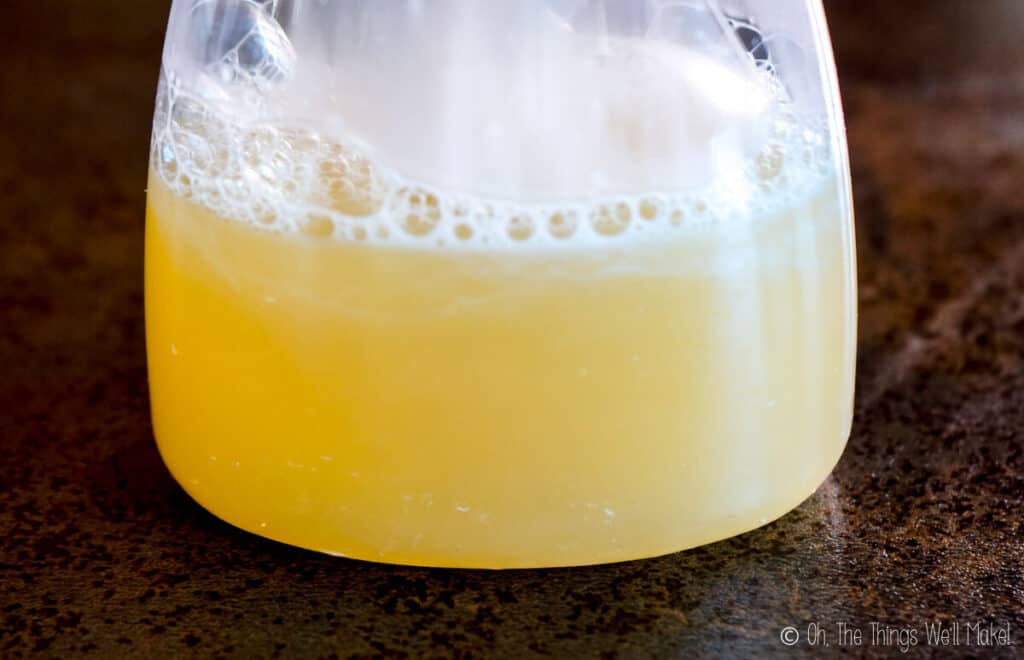
Soap made with jojoba oil 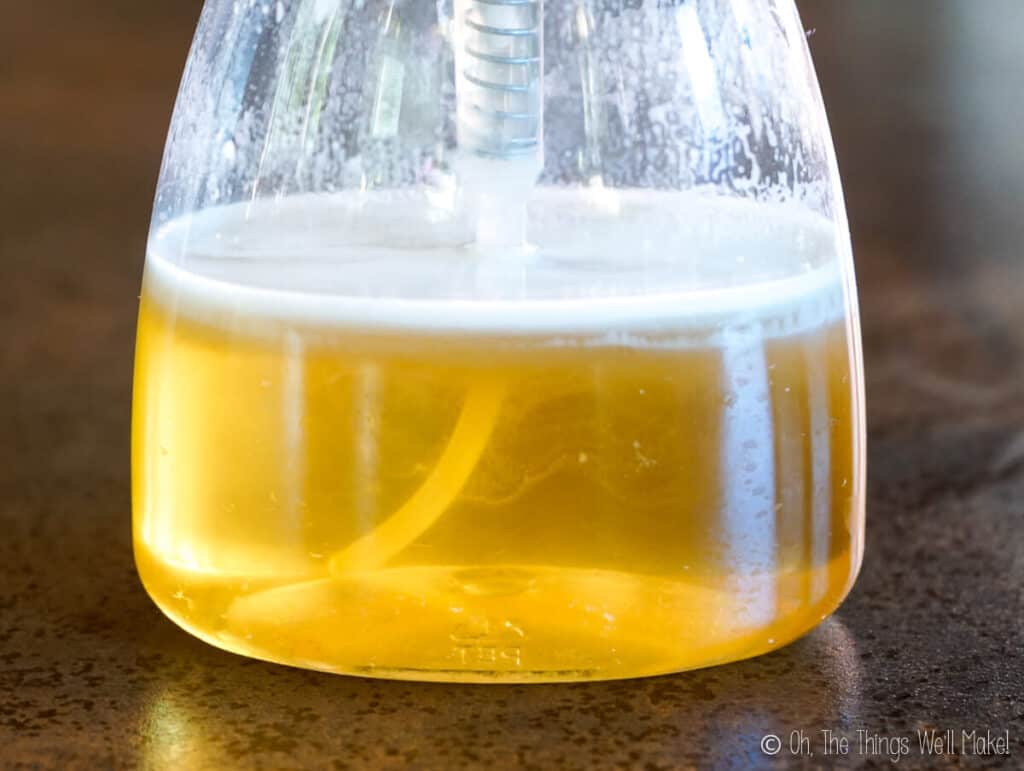
Once allowed to settle, the cloudy layer floats on top.
Tap water
I recommend using distilled water when making soaps and cosmetics. Distilled water is free from impurities and also of the minerals that are normally present in tap water. While making soap with tap water is generally safe (I’d pre-boil it, just to be on the safe side), it can cause cosmetic issues, especially in liquid soap.
I’ve had several readers who found that they were able to resolve the problem of cloudiness in their soap just by switching to distilled water instead of tap water.
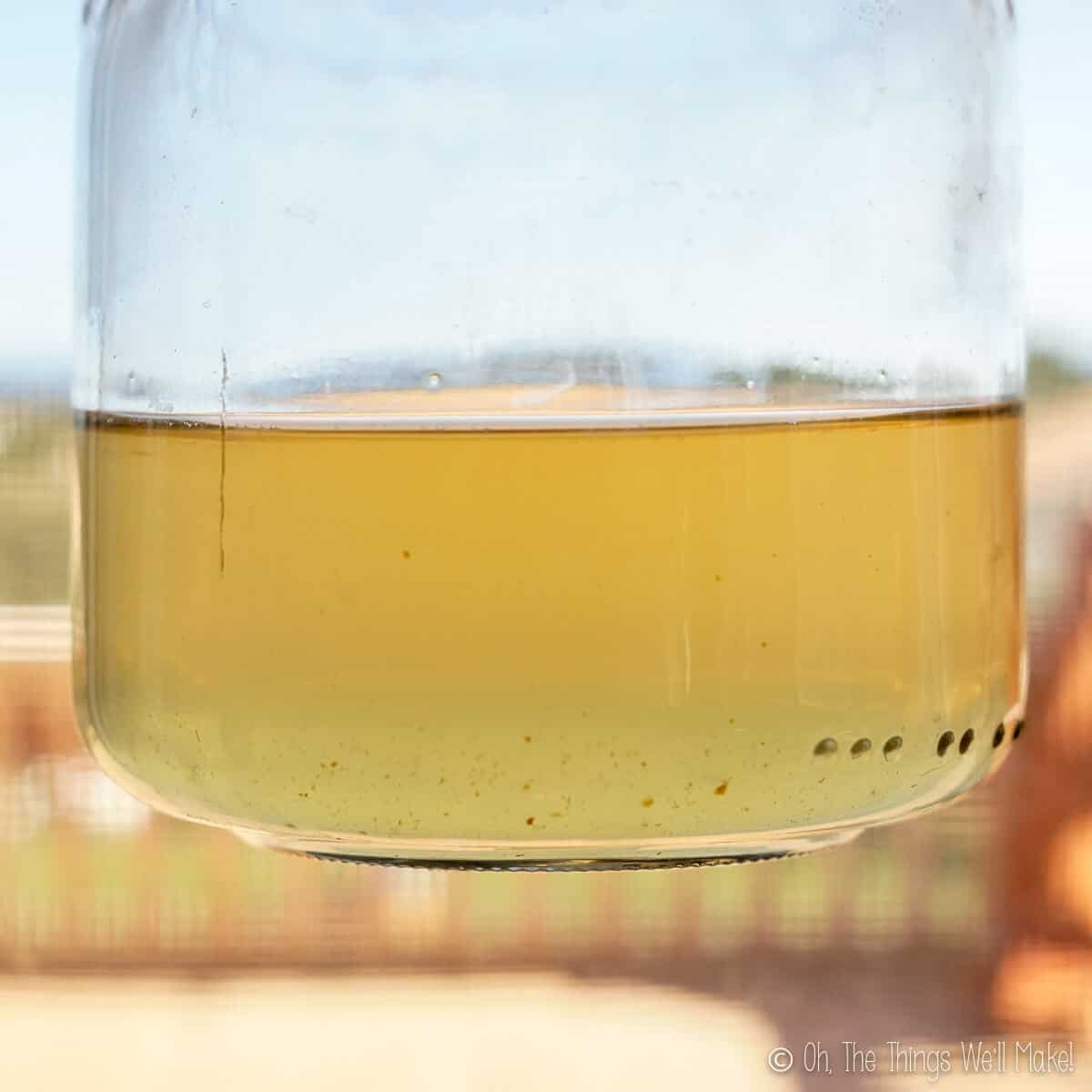
In the picture above, I had rinsed the pan used to bake a liquid soap paste with tap water. I saved the resulting liquid soap in a jar for use with general purpose cleaning. Some impurities from the pan have settled to the bottom, but the soap is still cloudy. It’s not as clear as the soap from the same batch that I dilute with distilled water. (In this case I did make the paste with distilled water.)
My liquid soap is milky (past cloudy)!
Normally, if you find a milky looking mixture when you mix your soap paste with distilled water, that is an indication that you have unsaponified oils in your soap paste. This may either be because of the oil used (jojoba has a lot of unsaponifiables) or because the recipe hasn’t been calculated well. You may be able to fix this problem by adding some more KOH solution to your melted down paste (if the recipe used too many oils).
Milkiness may also indicate that your soap paste hasn’t fully finished cooking and your soap hasn’t completely saponified. If you’ve been cooking your paste for hours, though, and you still have a milky substance when you dilute your soap paste in distilled water, you likely have another issue (like too many oils or the wrong types of oils).
Sequestering liquid soap
If you’re having issues with cloudiness or milkiness, one thing you can try is to allow the diluted soap to rest untouched for several days to weeks. During this “sequestration” time, any solids in the soap will likely settle to the bottom. The extra fats and unsaponifiables should float to the top, forming a cloudy layer. In the center, you should find that most of the liquid soap is clear.
If you’re careful, you may be able to remove the cloudy top layer, and then bottle up only the clear soap for using.
Why does my liquid soap irritate my skin?
If you find that your soap causes skin irritation, it may be an indication that you may have a lye excess. Having unreacted lye solution in your liquid soap can result in a liquid soap with a higher pH than normal. While soap is normally naturally alkaline, having a pH that is too high can be problematic, especially for people with sensitive skin.
Some people also find that soap, in general, is irritating to their skin. They may be more sensitive to the high pH of soap and may do better with a non-soap surfactant cleanser with a lower pH. (Read more about the importance of pH in cosmetics.)
How to fix it
If you think your soap may have a lye excess, you can perform a zap test or test the pH of your soap with test strips. (Unfortunately, test strips can be inaccurate with liquid soaps.)
You can try to slightly lower the pH of the soap with a citric acid solution. I have a lot more information about testing the pH of soap and “neutralizing” liquid soaps in my post about it.
Keep in mind, though, that soap can never fall into a neutral or acidic range. Trying to achieve that will make the soap fall apart and lose its cleansing ability. It will also make it cloudy, and make it much more prone to microbial growth.
The zap test
To check for safety of the soap, many soap makers rely on what is called the zap test. To zap test a liquid soap paste, run your wet finger over the surface of the paste and then touch your soap-covered finger to your tongue. If the soap is caustic, it gives a zapping sensation. (This has nothing to do with flavor.)
If the soap doesn’t zap (if you can’t tell, it doesn’t), then it doesn’t have any more active lye, and should be safe to use.
Moldy soap
While this subject is a bit controversial, it is normally said that soap is self-preserving and doesn’t really need any added preservatives. Soap is self-preserving because it has a high pH and falls into the alkaline range. Its pH isn’t hospitable to molds and pathogenic bacteria. There are some things that you could do, though, to make it more prone to microbial growth.
Soap can’t be brought into a neutral or acidic range, but some people still insist on trying. Adding acids to try to lower the pH of soap will make it fall apart and lose its cleansing ability.
Another possible problem is the addition of other ingredients. I’ve seen recipes on the internet for body washes made with soaps combined with food products like milk. Adding too many food and plant-based ingredients will not only make it less effective but will also make it extremely difficult to preserve.
Even adding something like honey, that is self-preserving on its own, can make a liquid soap more prone to microbial growth.
How to fix it
Trying to lower the pH of soap (too much), or adding food-type ingredients to your liquid soap can make it prone to microbial growth. So, don’t try to lower the pH too much!
If you do want to use a preservative, keep in mind that not all cosmetic preservatives will work for soap. In fact, there are very few preservatives that are effective in the pH range of soap. For more information about preserving soap, check out my guide to natural preservatives.
Conclusion
While that covers most of the frequently asked questions about liquid soap problems, I’m sure there are others that haven’t been covered. I’ll try to keep updating this post, as needed, as they come to my attention.
 Español
Español
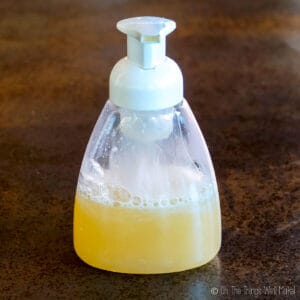
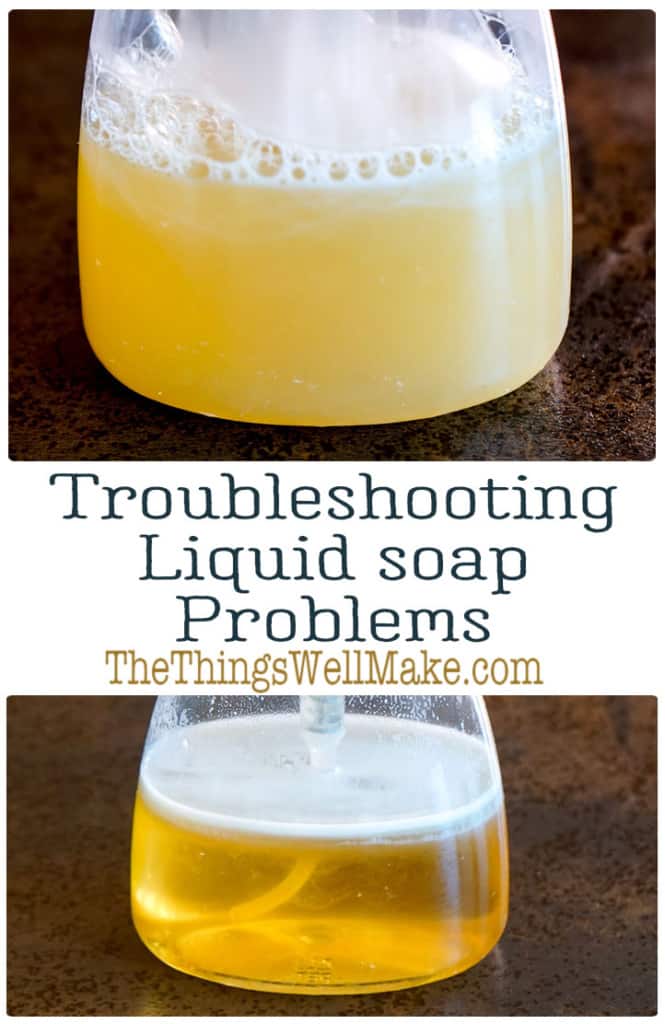
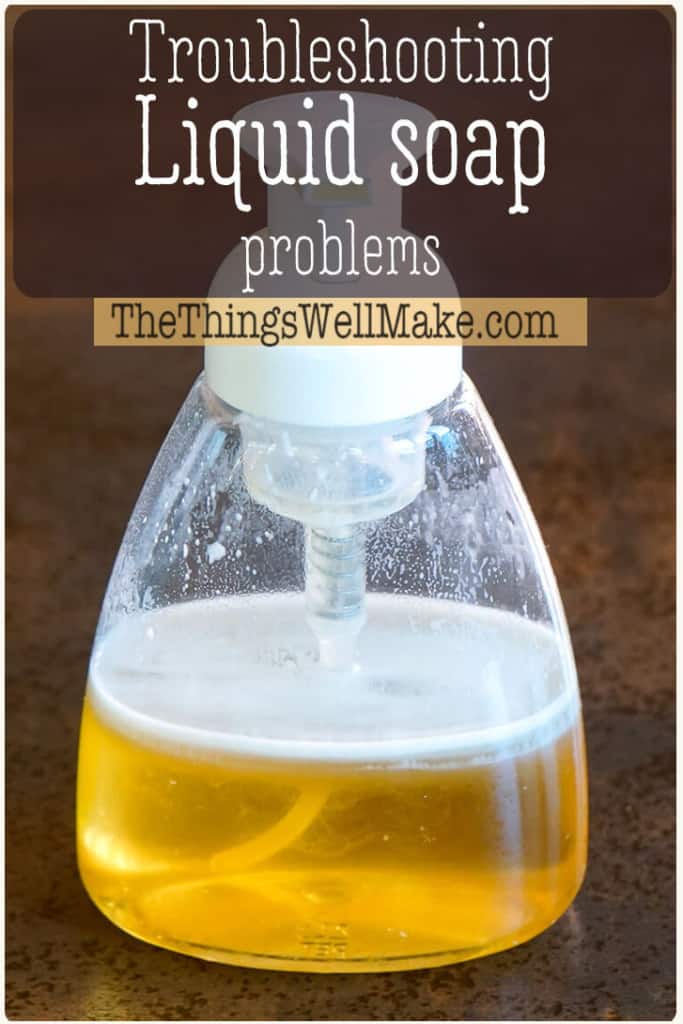
 How to make Kombucha From Scratch
How to make Kombucha From Scratch
Jessica
Hello I have just finished my first batch of liquid soap and am trying different dilution rates but even 2-1 is really really thin and the soap past separates to the bottom after only a few hours. is that normal? is there a way that I can thicken the entire mixture and maybe get the soap to not separate from the water? The paste its self is perfect thickness as best as I can tell. I’m a professional cold process bar soap maker but liquid soap is a whole different ball game! any help you could give me would be much appreciated!
Tracy Ariza, DDS
Hi Jessica,
It’s normal for liquid soap to be very thin. (Even Dr. bronners super concentrated soap is thin.)
To thicken it, you have several options. If it’s an olive oil liquid soap, you may be able to thicken it with a salt solution. Mix up a 20% solution and slowly add it in, stirring it in between additions until it gets thicker. (Don’t add too much or it gets weird.)
For other liquid soaps, the salt probably won’t work. You can thicken it with something like xanthan gum as I did in my shampoo recipe.
It’s not really normal for it to separate, but if you thicken it, I imagine that would be even less likely.
Esther
why does white foam or substance settle on my shower gel after a few weeks I make it
Tracy Ariza, DDS
Hi Esther,
What’s in your shower gel?
Without knowing what it is, I can’t really guess.
If you mix too many things with soap, though, to make a “gel ” or “wash”, you could definitely get some sort of microbial growth and that might be what you’re seeing. If you throw of the pH, it may also be separating.
I don’t like mixing soap with other things (other than a fragrance). I like to keep it clean.
Annebel
Hi Esther,
We tried making liquid soap with pure olive oil and with pure coconut oil. We made half the recipe with glycerin and half of it substituting the glycerin with water, just to see what would happen. Using the coconut oil it worked just fine, allthough the blending took much longer with the half with just water.
With the olive oil something strange happened. the batch with just water started to curdle and it wouldnot mix anymore. Finaly we put it in a glas jar and left it. After 2 days it suddenly looked like clear soappaste, but it was green instead of yellow. Do you have any idea what happened here?
I have pictures if that would help.
And if the soap passes the zapp test can we still use it?
TIA
Annebel
Tracy Ariza, DDS
Hi Annebel!
Yes, it should be fine to use.
The glycerin is there for just that- to make the process more foolproof and quicker. It also supposedly makes a paste that is easier to dissolve, and the finished soap may be a bit more conditioning when using.
I’ve done experiments with making a soap paste an intentionally not finishing it. Over time, when stored, it eventually gets clearer and turns into a proper soap paste. I imagine that’s what happened to you.
As for the color- it’s normal for olive oil soap to be darker in color than coconut oil soap. If your olive oil was on the greener side, that would explain the greener color.
Nisa Mendez
Hey,
I’m making liquid soap and have used your dr Bonners copycat updated version! Which is great however when I mix in the EOs and vitamin E and preservatives it’s seems to go clumpy and and thick on top then more liquid at the bottom, is this because of adding in the oils when it’s cold
Tracy Ariza, DDS
Hi Nisa,
It may depend on the EO used. I always add them when cold and have never had any issues.
Are you sure it isn’t a problem with your preservative? Most preservatives don’t work well with the pH of liquid soap.
Sunday Gbenga
Please, what are the possible causes of these defects in liquid soaps? High viscosity, soaps too harsh, little cleaning action. Thank you.
Tracy Ariza, DDS
Hello-
High viscosity- you probably just need to dilute more.
too harsh- either too much lye was used, or the soap paste wasn’t cooked enough to finish the saponification process. (Or poor choice of oils.)
Little cleaning action- probably a poor choice of oils. (Read my post on the best oils for soapmaking for more info.)
Fiskan
What can i add to my dishwash liquid to make it more forming?
Tracy Ariza, DDS
Are you talking about a liquid soap based cleanser or a true detergent?
Most soaps already foam quite a bit. For other surfactants, it depends on what’s in it.
Angela
Hi, I’m making the liquid Castile soap with light olive oil and a hydrosol instead of distilled water. They mixed together then separated but then came back together after blending . However it might be because I overheated the mixed, although the thermometer read under 85 degrees, the mixture became fluffy and whiter in colour. I don’t know what’s causing it but even after cooking it on “keep warm” for hours it still looks the same way. When I dissolved a bit in water it was cloudy even a bit milky. I’d really appreciate some help 🙂
Tracy Ariza, DDS
Hi Angela,
I’ve found that some “hydrosols” marketed as hydrosols actually have alcohol and other ingredients. I use distilled water for the making of the paste to rule out issues with the water when things go wrong. Even in bar soap, I used a homemade pure hydrosol once and it affected the outcome of my soap. It was darker in color and a bit strange.
I suggest making the paste itself with distilled water and then diluting the paste with hydrosols or a mix of hydrosols and water rather than making the paste with them.
It’s really imposible for me to know exactly what you’re using and how it may affect the process without trying it myself.
Lim KY
I make liquid hand soap in high temperature (>65 degC). I have added 7% of salt. Eventually, I get the viscosity (>1000mPa.s) but loses the gel feel.
Tiffini
Hi, I created the castille soap recipe and my problem is after diluting with the amout of water that was required for the recipe, My soap had clumps and keeps forming a thin layer on top. should I just add more distilled water at this point? the soap is really thick and slimy.
Tracy Ariza, DDS
Which recipe did you use?
The one that uses only olive oil and KOH?
Or did you try to dilute Abar soap made with NaOH?
Normally true liquid soaps will not get thick and will actually be very thin